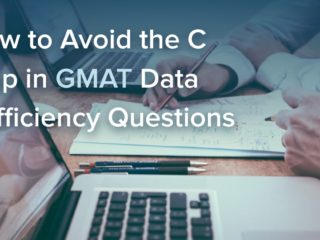| Getting your Trinity Audio player ready... |
Inequalities are undoubtedly a topic high on the GMAT Quant hit list. I’ll venture a guess that if you’ve found your way here, you’d like to learn more about GMAT inequalities questions, which happen to be a favorite of the question writers.
This article will cover GMAT inequalities: how to approach them, how to solve them, and some pretty cool inequality tricks. We will discuss problem-solving multiple-choice practice questions here, without covering inequalities Data Sufficiency tips because inequalities are not tested in Data Sufficiency questions on the new GMAT Focus.
Here are the topics we’ll cover:
- What Are Inequalities?
- Solving Basic Inequalities
- Multiplying or Dividing an Inequality by a Negative Number
- Multiplying or Dividing an Inequality by a Variable – Caution!
- Adding Inequalities
- Compound Inequalities
- Summary
- What’s Next?
Before jumping into our question bank of inequality GMAT questions and inequality GMAT tricks, let’s discuss some basic inequality concepts.
What Are Inequalities?
Just as an equation describes two expressions that are equal, an inequality describes two expressions that are not equal. We use the “greater than” symbol, >, and the “less than” symbol, <, when we are stating or solving inequalities. For example:
x = 5 is an equation that specifies the value of x as 5.
x > 7 is an inequality that specifies that x is any value greater than 7.
x < -4 is an inequality that specifies that x is any value less than -4.
KEY FACT:
An inequality describes two expressions that are not equal.
Note that the topic of inequalities includes problems with “less than or equal to”, ≤, or “greater than or equal to”, ≥. symbols. Thus, x ≤ 14 or x ≥ -8 are also considered inequalities. All the rules and techniques we cover in this article apply to inequalities with these symbols as well.
Solving Basic Inequalities
Equations and basic linear inequalities are solved identically, so there is no quantum leap going from equations to inequalities! If we solve for a variable or algebraic expression, we use the same algebraic techniques to isolate the variable and obtain its numerical solution. The difference between solving an equation and solving a basic inequality is not in the steps used to solve for the variable.
Rather, it is the statement of the solution: An equation yields a finite number of solutions, such as x = 3, whereas an inequality produces an interval for the values of the variable, such as x > 2, which can be shown on a number line. Make sure you have no issues understanding the number line.
Let’s solve an example of a basic inequality.
Example 1: Solving a Basic Inequality
What is the solution to (2x – 3) / 3 ≤ 1 ?
- x ≥ -3
- x ≤ -3
- x = 3
- x ≤ 3
- x ≥ 3
Solution:
We will solve this inequality using the same algebraic steps as we would for solving an equation. Our goal is to isolate x:
2x – 3 ≤ 3
2x ≤ 6
x ≤ 3
The solution set of x ≤ 3 indicates that x is equal to 3 or any number less than 3. On a number line, we would show this with a solid circle at 3 and an arrow pointing to the left of 3.
Answer: D
TTP PRO TIP:
Basic inequalities can be solved by using the same steps as you would to solve an equation.
Multiplying or Dividing an Inequality by a Negative Number
Okay, we are now getting into the weeds of inequalities. They are not all created equal! In the previous example, we solved an inequality exactly as we would an equation. We now find that there is a bit of a glitch in inequalities. When multiplying or dividing inequalities by a negative number, we have to reverse the direction of the inequality sign.
Let’s look at a simple example.
What is the solution set for the inequality -2x > 8 ?
Here, we see we have to divide by -2, But when we divide an inequality by a negative number, we must reverse the direction of the inequality sign.
So, when we divide -2x > 8 by -2, we reverse the inequality sign, obtaining:
-2x / -2 < 8 / -2
x < -4
KEY FACT:
If we multiply or divide an inequality by a negative number, we must reverse the direction of the inequality sign.
You might wonder why this rule is required. Let’s look at a quick illustration:
First, we know that 9 > 5, right?
But if we multiply both sides of this inequality by -1, we obtain:
-9 > -5, and that is wrong!
We started on the positive side of the number line. When we multiplied by -1, we were catapulted into the negative side of the number line, where all comparisons are reversed. Thus, we see that 9 > 5, BUT -9 < -5.
When we go from one side of the number line to the other, all numerical relationships are reversed. That is why we must reverse the direction of the inequality sign when we multiply or divide an inequality by a negative number.
Let’s practice with an example.
Example 2: Solving an Inequality when Multiplying or Dividing by a Negative Number
If -4x – 2 ≥ 3x – 5, which of the following cannot be a value of x ?
- 2
- 1/4
- 0
- -1/4
- -2
Solution:
First, let’s solve for x, remembering that if we multiply or divide by a negative number, we must reverse the direction of the inequality sign.
-4x – 2 ≥ 3x – 5
-7x ≥ -3
x ≤ 3/7
Let’s use the number line to determine which answer choice is not in the solution set.
All answer choices except x = 2 are in the solution set.
Answer: A
Multiplying or Dividing an Inequality by a Variable – Caution!
We have just learned that when we multiply or divide an inequality by a negative number, we must reverse the direction of the inequality sign. But there is a similar situation that can trick you every time unless you’re very, very careful. And that is multiplying or dividing an inequality by a variable.
Consider this quick example:
If 2xy < 10y, what is the range of possible values for x ?
We might be tempted to immediately divide both sides by 2y, obtaining x < 5 as the solution. However, this is not allowed because we don’t know the sign of y. Let’s look at the two possible solutions, depending on the sign of y.
Let’s suppose y = 1. Substituting this into the inequality, we have 2x(1) < 10(1), and x < 5.
But if, instead, y = -1, then we have 2x(-1) < 10(-1) → -2x < -10 → x > 5.
We see that the “correct” solution set depends on the sign of y. If we don’t know whether y is positive or negative, we cannot determine a valid answer for the range of possible values for x.
KEY FACT:
We cannot divide an inequality by a variable unless we know the sign of the variable.
Let’s take a look at an example.
Example 3: Multiplying an Inequality by a Variable
If 3p / 3q > 1, then which of the following statements could be true?
- p = q
- p > q
- p < q
- I only
- II only
- III only
- I and III only
- II and III only
Solution:
The question asks what could be the relationship between p and q. Because we are not given any information about the value of q, we must solve the inequality for two cases.
Case 1: q is positive
Let’s first simplify the inequality. After dividing by 3, we have p / q > 1. Now we multiply the inequality by q, obtaining p > q. Thus, we see that statement II could be true if q is positive.
Case 2: q is negative
After dividing by 3, the simplified inequality is p / q > 1. Now, we multiply the inequality by q. Because q is negative, we must reverse the direction of the inequality sign, obtaining p < q. In this case, we see that statement III could be true.
Finally, let’s consider statement I. Because the two possible cases resulted in p > q and p < q, it is not possible that p = q.
Therefore, only statements II and III could be true.
Answer: E
Adding Inequalities
More good news! If you already know how to add linear equations, you can add inequalities. However, there is one major thing to look out for. You can add inequalities only when the signs are facing the same direction!
TTP PRO TIP:
Inequalities can be added only when the signs face the same direction.
For example, we can add x + y > 8 and x – y > 6. Doing so gives us:
2x > 14
x > 7
On the other hand, we cannot immediately add 2x + y > 8 and x + y < 6 because the signs are not facing the same direction. But if we perform a simple transformation — multiplying the entire inequality x + y < 6 by -1 — then we can add the inequalities. Let’s see how this works:
-1(x + y < 6) = -x -y > -6
Now the two inequalities can be added:
2x + y > 8
+ -x – y > -6
x > 2
Let’s practice with an example.
Example 4: Adding Inequalities
For the inequalities -x + 3y > 8 and -2x + 3y < 13, which of the following must be true?
- x < -5
- x > -5
- x > 0
- x > 5/3
- x < 5
Solution:
To determine the solution set, we can add the inequalities. Because the inequality signs face in opposite directions, we must multiply one of the inequalities by -1 to reverse the sign.
Let’s multiply the second inequality (-2x + 3y < 13) by -1, remembering to reverse the direction of the inequality sign.
-1(-2x + 3y < 13) = 2x – 3y > -13
Now we can add the two inequalities:
-x + 3y > 8
+ 2x – 3y > -13
x > -5
Answer: B
Next, let’s discuss compound inequalities.
Compound Inequalities
So far in this article, we have dealt with inequalities that contain just one inequality sign. Examples of these inequalities include x > 7 or 7x < 6.
However, we also must be familiar with compound inequalities (also known as three-part inequalities), which combine three expressions with two inequality signs. Here are a couple of examples of compound inequalities:
-4 < n < 10
From the compound inequality above, we can say that n is greater than -4 and less than 10.
18 < 2x + y < 39
From the compound inequality above, we can say that 2x + y is greater than 18 and less than 39.
TTP PRO TIP:
Compound inequalities combine three expressions with two inequality signs.
Now that we know about compound inequalities, let’s look at how to simplify them.
Simplifying Compound Inequalities
I have some more good news! Compound inequalities can be simplified and manipulated in the same ways that we’ve used with basic inequalities earlier in the article. Thus, there are two things to keep in mind when performing any sort of simplification or manipulation:
- What you do to one part of a compound inequality, you do to all parts.
- When multiplying or dividing a compound inequality by a negative number, you reverse the direction of both inequality signs.
Consider the following compound inequality:
-6 > -3n > -30
If we divide the compound inequality by -3, we have:
-6 / -3 < -3n / -3 < -30 / -3
2 < n < 10
Notice that when we divided each term by -3, we also flipped the inequality signs.
KEY FACT:
What you do to one part of a compound inequality, you do to all parts.
Let’s practice with an example.
Example 5: Compound Inequalities
If -8 < 4x + 2 < 16, how many nonnegative integers could be the value of x?
- 0
- 1
- 2
- 3
- 4
Solution:
First, we must solve the compound inequality -8 < 4x + 2 < 16.
-8 < 4x + 2 < 16
-10 < 4x < 14
-10/4 < x < 14/4
-5/2 < x < 7/2
-2.5 < x < 3.5
The possible integer values of x are -2, -1, 0, 1, 2, and 3. Of these, the nonnegative values are 0, 1, 2, and 3. Thus there are 4 possible nonnegative integer values of x.
Answer: E
Summary: GMAT Inequalities Questions
An inequality describes two expressions that are not equal.
A basic inequality is solved in the same way as a linear equation, but the solution is an interval on the number line instead of a specific value or set of a finite number of values.
The techniques and procedures for solving inequality problems on the GMAT are very similar to those used to solve linear equations, but there are two caveats:
- If you multiply or divide an inequality by a negative number, you must reverse the direction of the inequality sign.
- In order to multiply or divide an inequality by a variable, you must know whether the variable is positive or negative.
Just like linear equations, you can add two inequalities. However, the inequality signs must be facing in the same direction before you can add them.
Finally, compound inequalities contain two inequality signs and three expressions. There are two key rules to remember:
- What you do to one part of the inequality, you must do to all parts.
- If you multiply or divide one part of a compound inequality by a negative number, you must reverse the direction of the sign for all parts of the inequality.
In this article, we solved a variety of PS (Problem Solving) multiple-choice questions. Note that we didn’t encounter any DS (Data Sufficiency) inequalities questions here because the GMAT Focus does not test inequalities concepts in DS questions.
What’s Next?
Solid understanding and mastery of inequalities are critical for earning a great GMAT score. But this is only one topic out of dozens on the exam. To get a handle on the entire GMAT Quant section, read our article about tips for improving your GMAT quant score.



